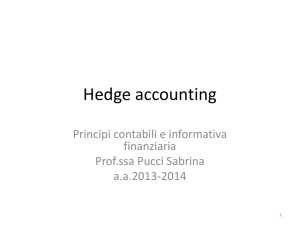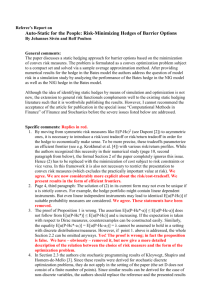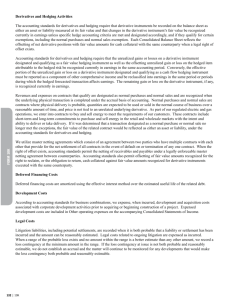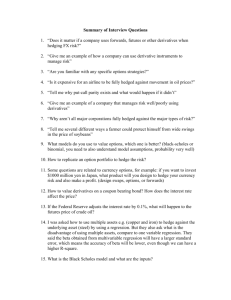the hedging instrument
advertisement
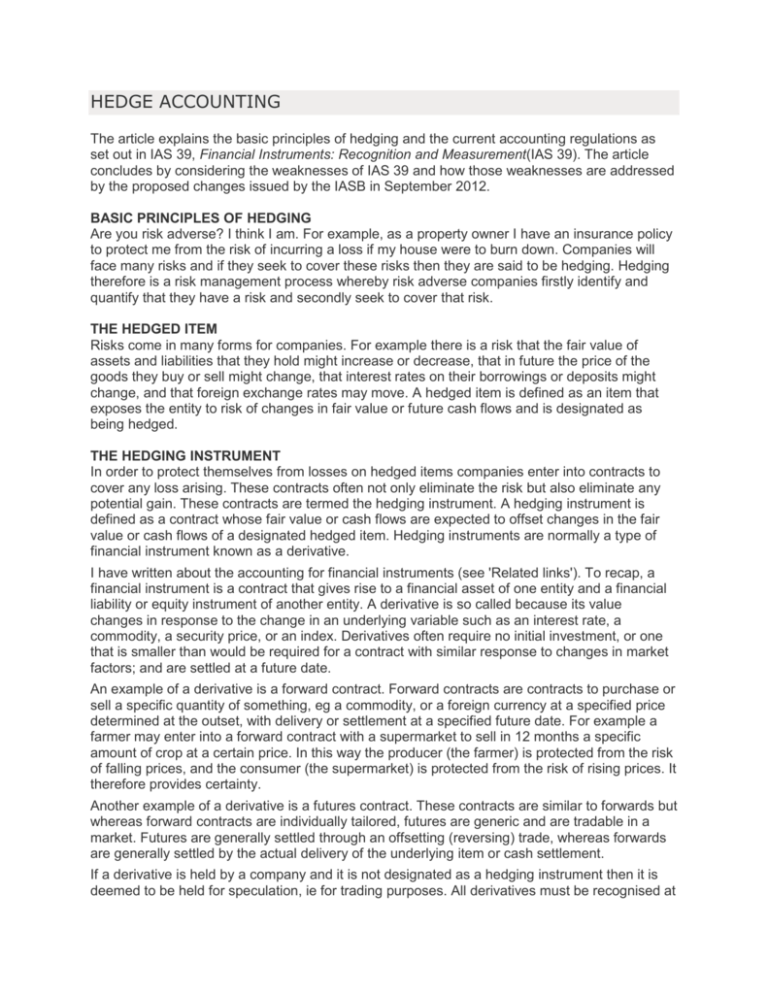
HEDGE ACCOUNTING The article explains the basic principles of hedging and the current accounting regulations as set out in IAS 39, Financial Instruments: Recognition and Measurement(IAS 39). The article concludes by considering the weaknesses of IAS 39 and how those weaknesses are addressed by the proposed changes issued by the IASB in September 2012. BASIC PRINCIPLES OF HEDGING Are you risk adverse? I think I am. For example, as a property owner I have an insurance policy to protect me from the risk of incurring a loss if my house were to burn down. Companies will face many risks and if they seek to cover these risks then they are said to be hedging. Hedging therefore is a risk management process whereby risk adverse companies firstly identify and quantify that they have a risk and secondly seek to cover that risk. THE HEDGED ITEM Risks come in many forms for companies. For example there is a risk that the fair value of assets and liabilities that they hold might increase or decrease, that in future the price of the goods they buy or sell might change, that interest rates on their borrowings or deposits might change, and that foreign exchange rates may move. A hedged item is defined as an item that exposes the entity to risk of changes in fair value or future cash flows and is designated as being hedged. THE HEDGING INSTRUMENT In order to protect themselves from losses on hedged items companies enter into contracts to cover any loss arising. These contracts often not only eliminate the risk but also eliminate any potential gain. These contracts are termed the hedging instrument. A hedging instrument is defined as a contract whose fair value or cash flows are expected to offset changes in the fair value or cash flows of a designated hedged item. Hedging instruments are normally a type of financial instrument known as a derivative. I have written about the accounting for financial instruments (see 'Related links'). To recap, a financial instrument is a contract that gives rise to a financial asset of one entity and a financial liability or equity instrument of another entity. A derivative is so called because its value changes in response to the change in an underlying variable such as an interest rate, a commodity, a security price, or an index. Derivatives often require no initial investment, or one that is smaller than would be required for a contract with similar response to changes in market factors; and are settled at a future date. An example of a derivative is a forward contract. Forward contracts are contracts to purchase or sell a specific quantity of something, eg a commodity, or a foreign currency at a specified price determined at the outset, with delivery or settlement at a specified future date. For example a farmer may enter into a forward contract with a supermarket to sell in 12 months a specific amount of crop at a certain price. In this way the producer (the farmer) is protected from the risk of falling prices, and the consumer (the supermarket) is protected from the risk of rising prices. It therefore provides certainty. Another example of a derivative is a futures contract. These contracts are similar to forwards but whereas forward contracts are individually tailored, futures are generic and are tradable in a market. Futures are generally settled through an offsetting (reversing) trade, whereas forwards are generally settled by the actual delivery of the underlying item or cash settlement. If a derivative is held by a company and it is not designated as a hedging instrument then it is deemed to be held for speculation, ie for trading purposes. All derivatives must be recognised at fair value on the statement of financial of position – this is sometimes referred as being ‘marked to market’. As the value of derivatives can be very unstable and so can generate large gains and losses in a short period, derivatives cannot be carried at historic cost (which is often nil anyway) as this would result in large gains and losses being unreported. If the derivative is not designated as a hedging instrument then any gains or losses arising are recognised in the statement of profit of loss. This is fair enough as the rightful place for trading profits and losses is the statement of profit or loss. BASIC PRINCIPLES HEDGE ACCOUNTING AND EFFECTIVENESS In essence the principle of hedge accounting is that it seeks to reflect the substance of why the hedging instrument (the derivative) has been entered into. To that end hedge accounting is trying to match any loss (or gain) on the hedged item with the gain (or loss) on the hedging instrument. In a perfect world hedging would work so that no net gain or loss arose. For example if the hedged item created a loss of say $500m it would then be matched by a gain on the hedging instrument of $500m. This would be a perfect hedge, a hedge with 100% effectiveness. However we do not live in a perfect world so a 100% effective hedge is highly unlikely. So if the hedged item created a loss of $500m and the hedging instrument a gain of $450m then the hedge would said to be 90% effective (450/500 = 90%). IAS 39 – THE CURRENT REGULATION IAS 39 regulates what can be designated a hedged item, a hedging instrument, when a hedging relationship exists and also how to account for the gains and losses on certain types of hedging relationships. IAS 39 regulates that a hedged item can be: a single recognised asset or liability, firm commitment, or a highly probable transaction a group of assets, liabilities, firm commitments, or highly probable forecast transactions an investment for foreign currency or credit risk (but not for interest risk or prepayment risk) a portion of the cash flows or fair value of a financial asset or financial liability a non-financial item for foreign currency risk only for all risks of the entire item a portfolio hedge of interest rate risk (Macro Hedge) only a portion of the portfolio of financial assets or financial liabilities that share the risk being hedged. IAS 39 regulates that hedging instruments can be derivative contracts with an external counterparty, except for some written options. However a non-derivative financial asset or liability may not be designated as a hedging instrument except as a hedge of foreign currency risk. (This is quite a rule-based approach!) IAS 39 permits hedge accounting under certain circumstances provided that the hedging relationship is: formally designated and documented at inception, including the entity's risk management objective and strategy for undertaking the hedge, identification of the hedging instrument, the hedged item, the nature of the risk being hedged, and how the entity will assess the hedging instrument's effectiveness, and expected to be highly effective in achieving offsetting changes in fair value or cash flows attributable to the hedged risk as designated and documented, and effectiveness can be reliably measured, and assessed on an ongoing basis and determined to have been highly effective. Effectiveness is the extent to which the instrument offsets changes in fair value or cash flows attributable to the hedged risk. A hedge is highly effective if that offset falls within a 80–125% window. Hedge effectiveness has to be assessed both prospectively and retrospectively. All hedge ineffectiveness is recognised immediately in the statement of profit or loss (including ineffectiveness within the 80% to 125% window). While IAS 39 recognises three categories of hedge, only two are examinable in Paper P2, Corporate Reporting. These are fair value hedges and cash flow hedges. FAIR VALUE HEDGE A fair value hedge is defined as a hedge of the exposure to changes in fair value of a recognised asset or liability. For example, if a company has an asset that it is concerned will fall in value it can designate this as a hedged item and enter into a derivative that is designed to match any change in the fair value of the asset, and this derivative is then designated as a hedging instrument. The accounting for a fair value hedge is that the gain (or loss) from the change in fair value of the hedging instrument is recognised immediately in the statement of profit or loss. At the same time the carrying amount of the hedged item is adjusted for the corresponding loss (or gain) with respect to the hedged risk, which is also recognised immediately in the statement of profit or loss. This is instant hedge accounting as the gains and losses offset in the statement of profit or loss. A fair value hedge is taken to the statement of profit or loss. EXAMPLE OF A FAIR VALUE HEDGE For example a company has an asset with a current fair value of $200m that it is concerned will fall in value, so designates this to be a hedged item and enters into a derivative designated as a hedging instrument. This is a fair value hedge. Let us suppose at the next reporting date the fair value of the hedged item has fallen to $160m thus creating a loss of $40m. However, because it is a hedged item the hedging instrument (the derivative) should create a gain. If the gain on the hedging instrument is $45m, then the hedge is assessed as being 112.5% effective (45/40 = 112.5%). This is within the permitted band of 80% – 125%. As a result of applying fair value hedge accounting and matching the loss on the hedged item with the gain on the hedging instrument, the loss of $40m and the gain of $45m will offset to report a net gain of $5m in the statement of profit or loss. CASH FLOW HEDGE A cash flow hedge is defined as a hedge of the exposure to variability in cash flows that is attributable to a particular risk associated with a recognised asset or liability (such as all or some future interest payments on variable rate debt) or a highly probable forecast transaction and could affect profit or loss. For example, if a company is concerned that the price it will have to pay for next year's raw materials will rise it can designate this as a hedged item and enter into a derivative (eg a futures contract designed to cover any price rise) which it designates as a hedging instrument. Similarly, if a company is concerned that interest rates will rise on its debt finance, then it could designate this as a hedged item and enter into a derivative (eg an interest rate swap) which it designates as a hedging instrument. The portion of the gain or loss on the hedging instrument that is determined to be an effective cash flow hedge is recognised in other comprehensive income and creates a reserve in equity. If a hedge of a forecast transaction subsequently results in the recognition of a financial asset or a financial liability, any gain or loss on the hedging instrument that was previously recognised directly in equity is recycled from reserves into the statement of profit or loss in the same period(s) in which the financial asset or liability affects profit or loss. If a hedge of a forecast transaction subsequently results in the recognition of a non-financial asset, then the entity has an accounting policy option that must be applied to all such hedges of forecast transactions. One policy is to apply the same accounting as for recognition of a financial asset or financial liability, in that any gain or loss on the hedging instrument that was previously recognised in other comprehensive income is recycled from reserves into the statement of profit or loss in the same period(s) in which the non-financial asset or liability affects profit or loss. The other policy is to make an adjustment on the acquired non-financial asset so that the gain or loss on the hedging instrument that was previously recognised in other comprehensive income is removed from reserves and is included in the initial measurement of the acquired non-financial asset. EXAMPLE OF A CASH FLOW HEDGE For example during year 1, a company is planning to buy an asset in the next accounting period at a an estimated cost of $100m but it is concerned that the cost of buying the asset will rise. The company can designate the risk of the future cash out flows rising as a hedged item and enter into a derivative, the hedging instrument to cover this risk. This is a cash flow hedge. Let us suppose at the year 1 reporting date the estimated cost of the asset had risen to $120m and the hedging instrument was reporting a gain of $19m then the hedge is 95% effective (19/20 = 95%) and so within the 80%–125% rule. The gain of $19m that has arisen in respect of the derivative has to be recognised, and as it is the hedging instrument of a cash flow hedge, it is recognised in other comprehensive income and creates a reserve (often called other components of equity). The gain (or loss) on a derivative that is designated as a cash flow hedge is in effect carried forward and is delayed being recognised in the statement of profit of loss. There can be no offset in the current accounting period as the potential extra cost of $20m of buying the assets is a notional number and not one that is yet recognised in the financial statements, as after all the asset has yet to be bought. As an aside, sticking with the example that the hedging instrument reports a gain of $19m if we were to assume that the cost of the asset had only risen by $9.5m then the cash flow hedge would be 200% effective (19/9.5 = 200%) and therefore outside of the 80–125% effectiveness rule. The hedging relationship is not highly effective and therefore hedge accounting is not permitted. The whole $19m gain on the hedging instrument must therefore be recognised in the statement of profit or loss. However, assuming as we did in the first place, that the hedge was effective at the reporting date and we then jump forward a few months into the middle of year 2 and further assume that the asset is indeed bought for $120m and is a financial asset, then the previously recognised gain of $19m on the hedging instrument sitting in reserves is recycled from equity and recognised in the statement of profit or loss. Recycling has meant that this gain of $19m has appeared within the statement of comprehensive income in two consecutive years, firstly in other comprehensive income and secondly in the statement of profit or loss. Many argue that recycling is double counting and therefore inappropriate. This is one of the few remaining situations of recycling being permitted by reporting standards. For example IAS 16,Property, Plant and Equipment clearly prohibits the recycling of previously recognised gains on the disposal of revalued property. The other comprehensive statement must clearly distinguish between those gains and losses which may or may not be recycled to the statement of profit or loss in future periods. If the asset is a non-financial asset – for example, inventory that is sold in the accounting period – then the previously recognised gain of $19m on the hedging instrument can be recycled from its reserve in equity and recognised in the statement of profit or loss. However, if the asset is property, plant and equipment, then the reserve would be recycled over the useful life of the property, plant and equipment. ISSUES WITH IAS 39 AND HOW THE PROPOSALS ADDRESS THEM IAS 39 takes a rules-based approach to hedge accounting and these rules are often complex and sometimes contradictory. An example of this is the quantitative effectiveness rule of 80%– 125%. These are arbitrary numbers. It has also been argued that requirements to perform quantitative effectiveness tests are onerous and that there is insufficient guidance on how to actually quantify hedge effectiveness. Under the new proposals the assessment of hedge effectiveness will only be required on a prospective basis and the 80%–125% test for hedge effectiveness testing will be dropped. The hedge effectiveness will assessed by a review of the risk management strategy – with a requirement that no systematic under or over hedging is expected. Under the proposals a hedging relationship must comply with the following to qualify for hedge accounting: there should be an economic relationship between the hedging instrument and the hedged item the effect of credit risk should not dominate the value changes that result from that economic relationship, and the hedge ratio should reflect the actual quantity of hedging instrument used to hedge the actual quantity of hedge item. In other words this is a more principles-based approach. IAS 39 requires a different accounting treatment depending on whether the hedge is classified as a fair value hedge or a cash flow hedge. With a fair value hedge the gain or loss on the hedging instrument is recognised in the statement of profit or loss whilst with the cash flow hedge the gain or loss on the hedging instrument is initially recognised in the other comprehensive income with the potential for it being recycled to the statement of profit or loss at a later date. Accordingly similar items are being treated in an inconsistent manner, which is not ideal. Further it can be difficult to distinguish between a fair value hedge and a cash flow hedge. IAS 39 allows hedge accounting to be optional. Therefore, even if a company does actually hedge and complies with the current rules they do not need to apply hedge accounting. The rules-based approach to hedge accounting also results in some companies who do hedge not being able to apply hedge accounting because they fall foul of the rules. An example of this is the inability to apply hedge accounting for specific components of non-financial items. For example an airline wishing to protect itself from changes in aircraft fuel prices can in reality do so by entering into forward crude oil contracts. This is because crude oil is a major component of aircraft fuel and the price of aircraft fuel will be closely correlated to crude oil prices. However, this is not considered a valid hedge under IAS 39 as the company can only account for a hedge of either the foreign currency risk, or the entire non-financial item (the purchase price of the aircraft fuel). Under the new proposals hedging by risk components will be permitted for both financial and non-financial items, if separately identifiable and measurable. In addition, hedging instruments can include non-derivatives and there are significant new disclosure requirements. CONCLUSION IAS 39’s restrictive rules have resulted in some companies not applying hedge accounting or changing their risk management approach to become eligible to apply hedge accounting. The proposed revision of the restrictions should cause changes in the risk management approach and more application of hedge accounting. Tom Clendon FCCA, Kaplan Financial


